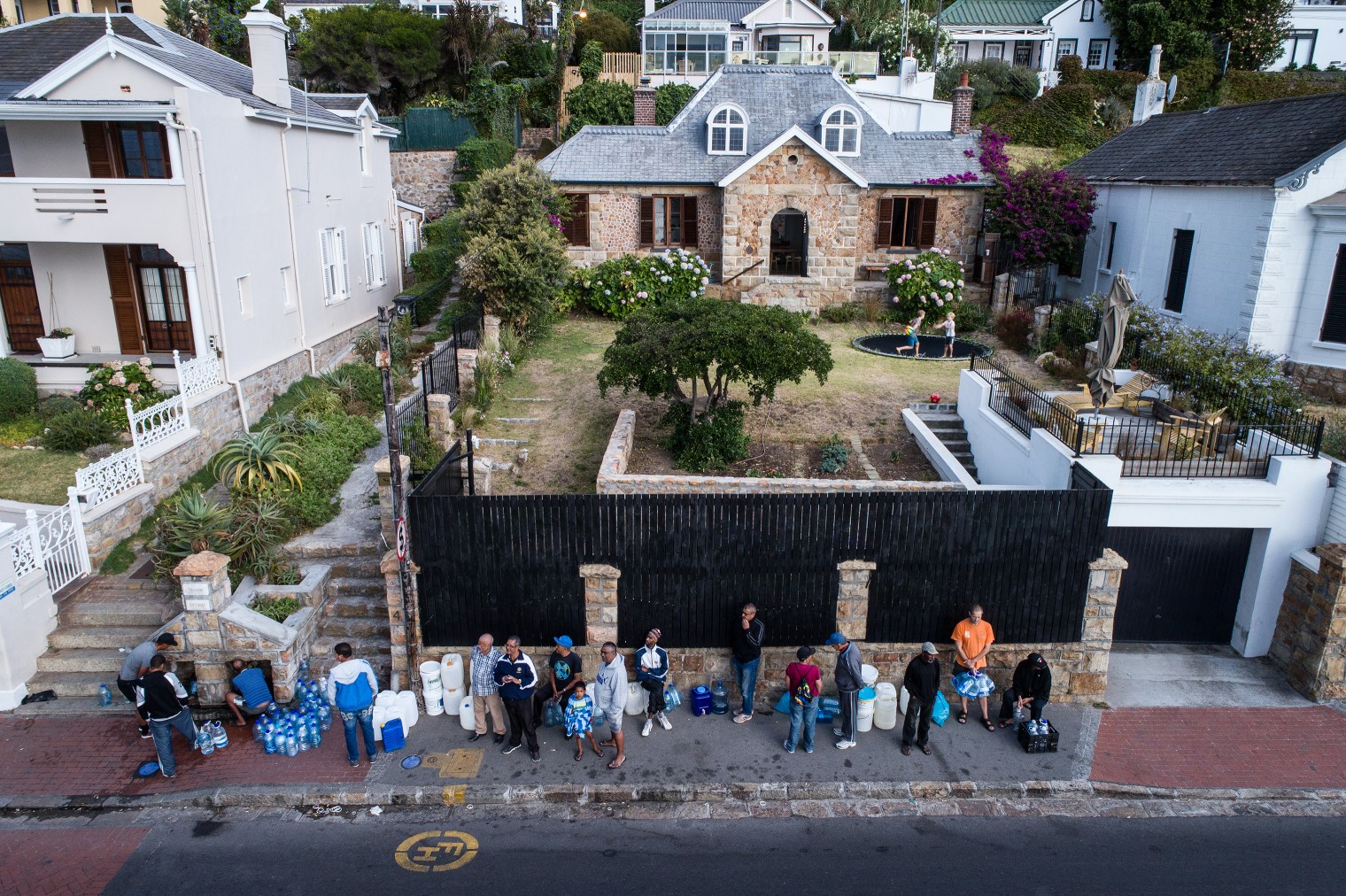 Capetonians collect water from the Kalk Bay spring on Feb. 1; at some springs, waits can drag on for hours. Mikhael Subotzky and Johnny Miller for TIME
Capetonians collect water from the Kalk Bay spring on Feb. 1; at some springs, waits can drag on for hours. Mikhael Subotzky and Johnny Miller for TIME
What It’s Like to Live Through Cape Town’s Massive Water Crisis
I knew we were in trouble when I found myself Googling dry composting toilets. That was on Feb. 1, just after the mayor’s office here in Cape Town announced new water restrictions. We are now limited to using 13 gallons of water per person per day. That’s enough for a 90-second shower, a half-gallon of drinking water, a sinkful to hand-wash dishes or laundry, one cooked meal, two hand washings, two teeth brushings and one toilet flush. I figured I could save an extra couple of gallons by forgoing the daily flush in favor of a dry composting toilet. Hippie friends living off the grid in the country do it. How bad could it be?
According to current projections, Cape Town will run out of water in a matter of months. This coastal paradise of 4 million on the southern tip of South Africa is to become the first modern major city in the world to completely run dry. And even though residents aren’t responsible, the burden of making sure it doesn’t happen rests largely on our ability to cut down on water usage. Dramatically.
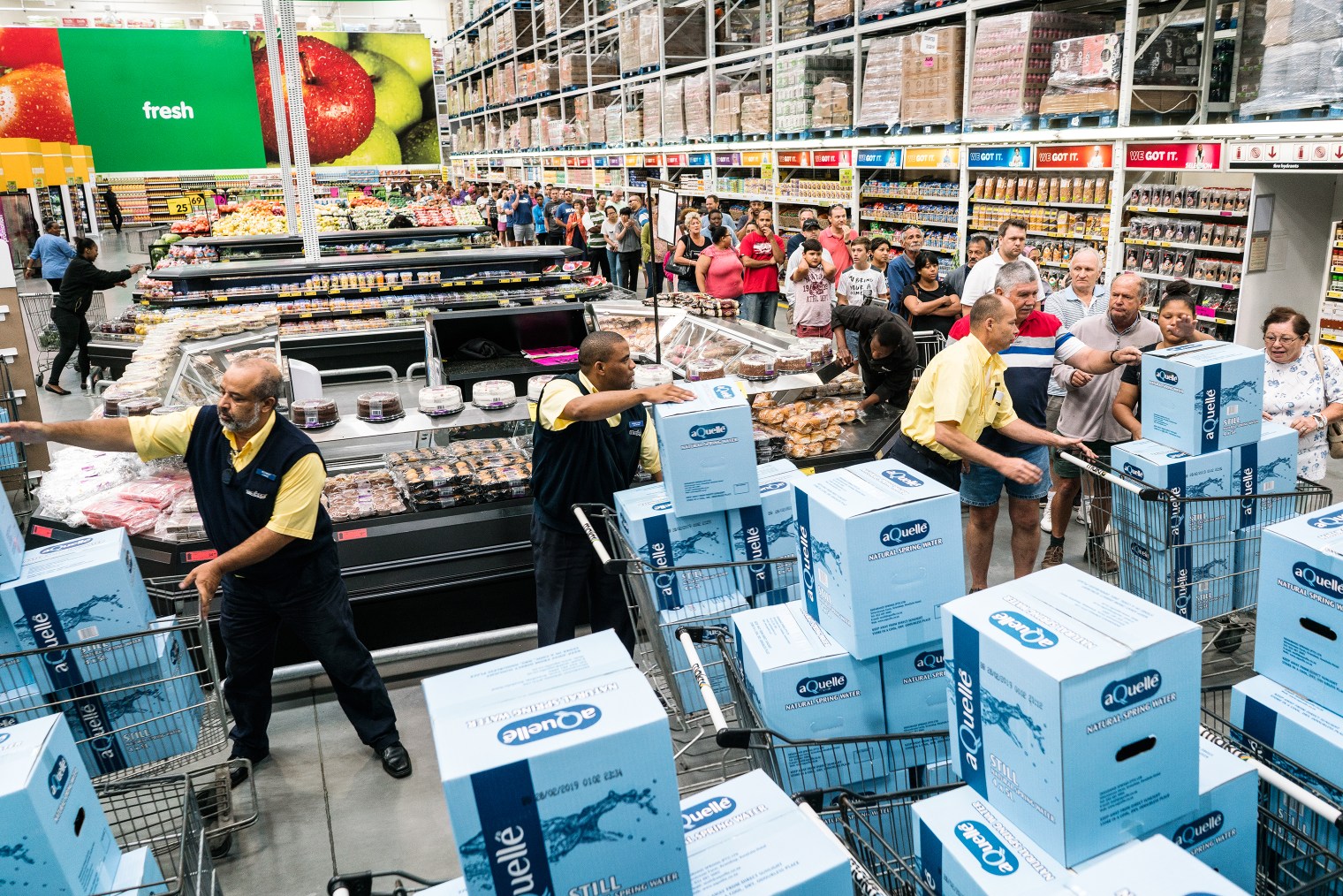 People queue to buy water at a grocery store in Milnerton, a suburb of Cape Town, on Feb. 3. Mikhael Subotzky—Magnum Photos for TIME
People queue to buy water at a grocery store in Milnerton, a suburb of Cape Town, on Feb. 3. Mikhael Subotzky—Magnum Photos for TIME
Millions of people around the world live without sufficient access to water. But Cape Town is no developing-world urban quagmire. It is a prosperous metropolis, a well-managed global tourist destination responsible for 9.9% of South Africa’s GDP, full of multimillion-dollar beachfront properties, art museums and two of the world’s top 50 restaurants. Cape Town running out of water is like San Diego going dry. Which, if you factor in the looming threat of climate change, may not be that far off. California’s five-year drought, which ended in 2016, had state officials scrambling to enact their own water restrictions. At one point, NASA warned that the state had less than a year’s supply in its reservoirs. As with the California dry spell, climatologists at the University of Cape Town say man-made global warming is a likely factor in the continued drought and that we, like many other cities around the globe, are facing a drier future with increasingly unpredictable rains. What is happening to us in Cape Town might not be an outlier. It could happen to you too.
The Cape Town crisis stems from a combination of poor planning, three years of drought and spectacularly bad crisis management. The city’s outdated water infrastructure has long struggled to keep up with the burgeoning population. As dam levels began to decline amid the first two years of drought, the default response by city leadership was a series of vague exhortations to be “water aware.” The water-saving appeals became more urgent in the past year. The rest of us prayed for rain.
It was only in September that Capetonians were given a limit of just over 23 gallons of water per day per person. By then the reservoirs were at a third of their capacity. But less than half of city residents met that goal—the tragedy of the commons, in action. As a result, with reservoirs down to the last dregs of accessible water, the 13-gallon limit we are asked to meet is less than the minimum U.N. daily recommendation for domestic water needs.
An even grimmer scenario now looms: Day Zero, when the government will turn off the taps for most homes and businesses in the city to conserve the very last supplies. Hospitals and other vital institutions in the city center will still get water, according to officials, but the majority of residents will have to line up at communal water points to collect their daily allotment of 6.6 gallons—about half our current, meager recommended limit—under the gaze of armed guards.
This dystopian scenario is no bluff. As of Feb. 5, Day Zero was predicted to fall on May 11, according to an analysis of current usage patterns and dam levels. Although a decline in agricultural use has shifted the date forward since the beginning of the year, there has been no significant reduction in urban consumption, according to the mayor’s office. Day Zero could just as easily be moved closer if city residents don’t continue to conserve. The looming shutdown has prompted chaos, with a run not only on bottled water but also on water tanks and jerricans. Once lush city parks and golf courses have withered, and public restrooms now urge visitors to flush only when absolutely necessary. High-end cafés use paper cups and plates to cut down on dishwashing. Many fear for their livelihoods; analysts estimate that the water crisis will cost some 300,000 jobs in agriculture and tens of thousands more in the service, hospitality and food sectors. If employees have to take time off from work to wait in line for water, it’s going to have an even greater impact on the economy.
Which brings me back to the composting toilet. Come Day Zero, there is no way I am going to flush more than a third of my precious daily water supply down a conventional toilet. Suddenly, spending $250 on a high-tech composting commode seems like a good deal. Until I read the fine print. The contents of the toilet must be allowed to mature for several months on a patch of well-drained soil, several meters away from human habitation. I live in a row house with a concrete terrace the size of two ping-pong tables. Now I’m picturing myself hauling buckets of human waste to the nearest farm.
City officials are urging families to stock up with an emergency supply of drinking water. It’s a wise suggestion, except for the fact that bottled water, especially the five-liter (1.1 gallon) version, is impossible to find. They sell out the minute they arrive in stores. My husband now drops off our daughter at school a half hour early so he can hit the supermarkets as soon as they open, hoping to score whatever water may have been delivered overnight. So far, he has had no luck. Even the shopkeepers don’t know when the next shipment will come in.
The next best option is to go to one of the city’s natural springs to fill up a jerrican, in an experience that feels like an early rehearsal for what is to come on Day Zero. At the Newlands spring, on the premises of a beer-bottling plant, lines undulate for hours down the street. People arrive long before the 5 a.m. opening, and brewery security guards police the crowd to ensure order. Official plans for Day Zero state that there will be approximately 200 water-collection points around the city, but many questions remain. A quick, back-of-the-envelope calculation suggests that even if only a quarter of residents show up to get their family allotment, each site will see some 5,000 water seekers a day. How will they transport the water? Where will they park? Even if each site has 50 to 200 taps each, as the city promises, the lines are likely to take hours.
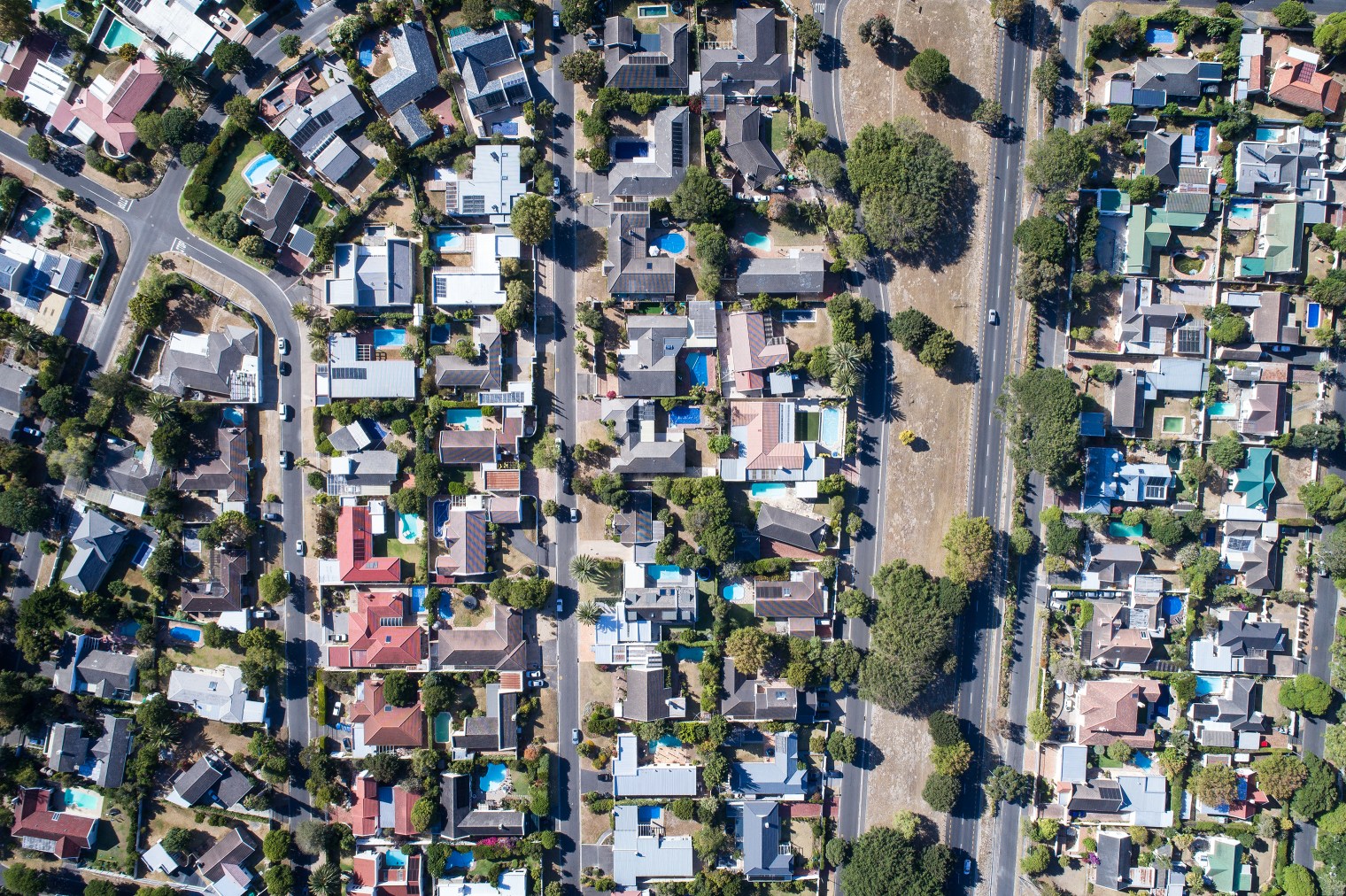 Swimming pools dot Kreupelbosch, an upscale Cape Town suburb, amid a worsening water crisis. Mikhael Subotzky and Johnny Miller for TIME
Swimming pools dot Kreupelbosch, an upscale Cape Town suburb, amid a worsening water crisis. Mikhael Subotzky and Johnny Miller for TIME
Lucky are the neighbors with pools—a built-in bathing option and emergency supply of water combined. For the past six months, it has been illegal to top up pools with municipal water; instead, most people buy well water trucked in by the tanker, sourced from outlying areas unaffected by the restrictions. The newly lucrative business sits in a legal gray area.
Technically, it’s illegal to sell water from wells or rivers, but you can charge for labor and transport. In listings on the local version of Craigslist, aquapreneurs are offering to “deliver” water for 4.5 rand, or 36¢, a gallon. If you want drinkable water, it will cost more.
Despite lacking a pool, I figured stockpiling that kind of water would help mitigate any Day Zero chaos. All I needed was a big tank. I wasn’t the only person with this idea. All the hardware stores told me there was a six-to-eight-week waiting list for new stock, but a friend knew someone who knew a guy who could get one quicker, if I was willing to pay. I pulled into a sand-dusted parking lot only to be shown a pair of plastic barrels that didn’t look as if they would hold a cup of tea, let alone hundreds of gallons. He was charging $350 each, nearly twice the market price of even the best-quality tanks.
I kicked myself for my lack of foresight. Four months ago, I could have filled up an affordable top-of-the-line tank with the spring rainwater gushing from my roof. Instead I let myself be swayed by soothing assurances from Mayor Patricia de Lille that she would “not allow a well-run city to run out of water.” Like the rest of us, the mayor was in denial. It is no small consolation that she has since been removed from her water-crisis-management duties and is facing a vote of no confidence in city government.
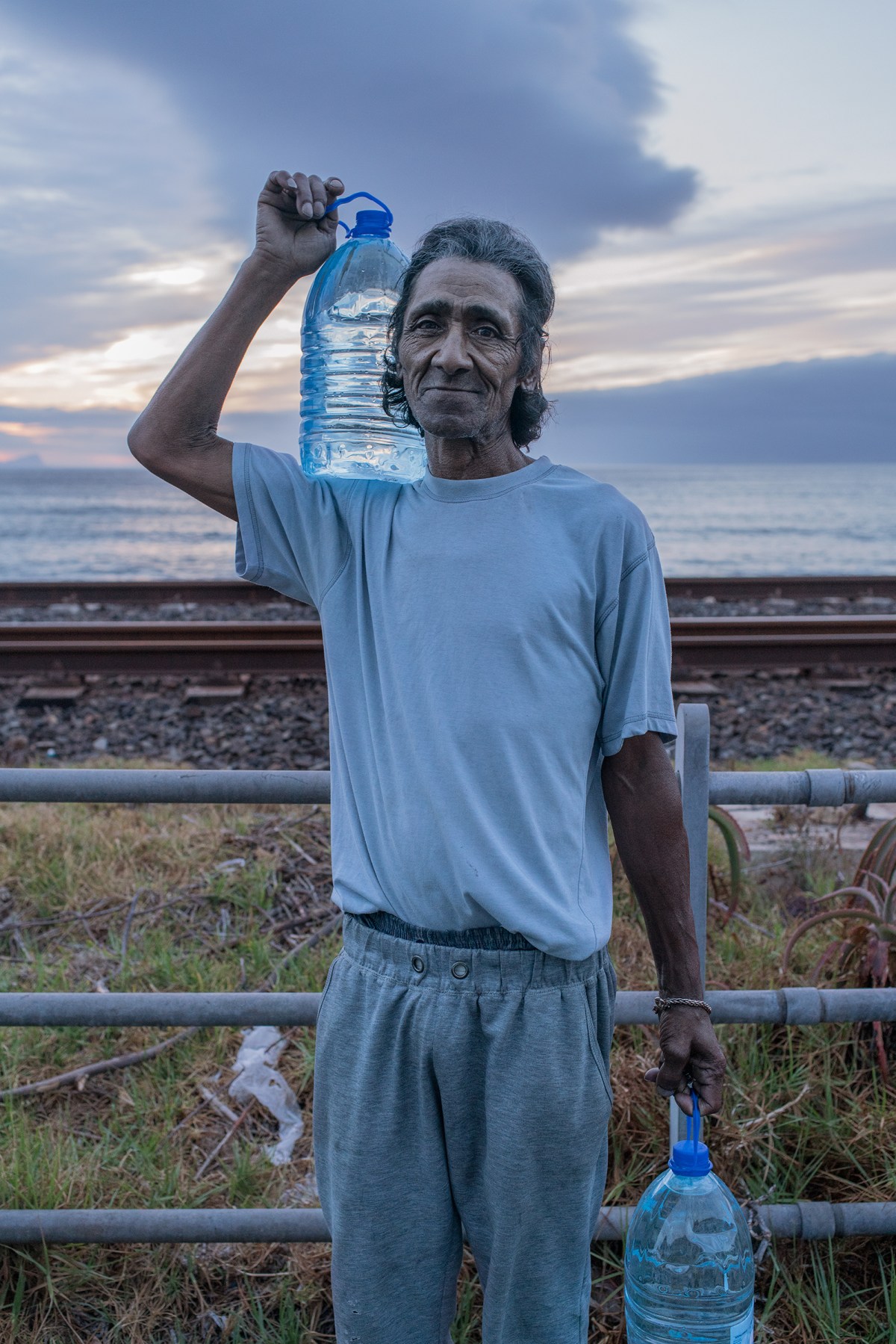 Aubrey Witbooi carries water from the Kalk Bay spring on Feb. 1. Mikhael Subotzky—Magnum Photos for TIME
Aubrey Witbooi carries water from the Kalk Bay spring on Feb. 1. Mikhael Subotzky—Magnum Photos for TIME
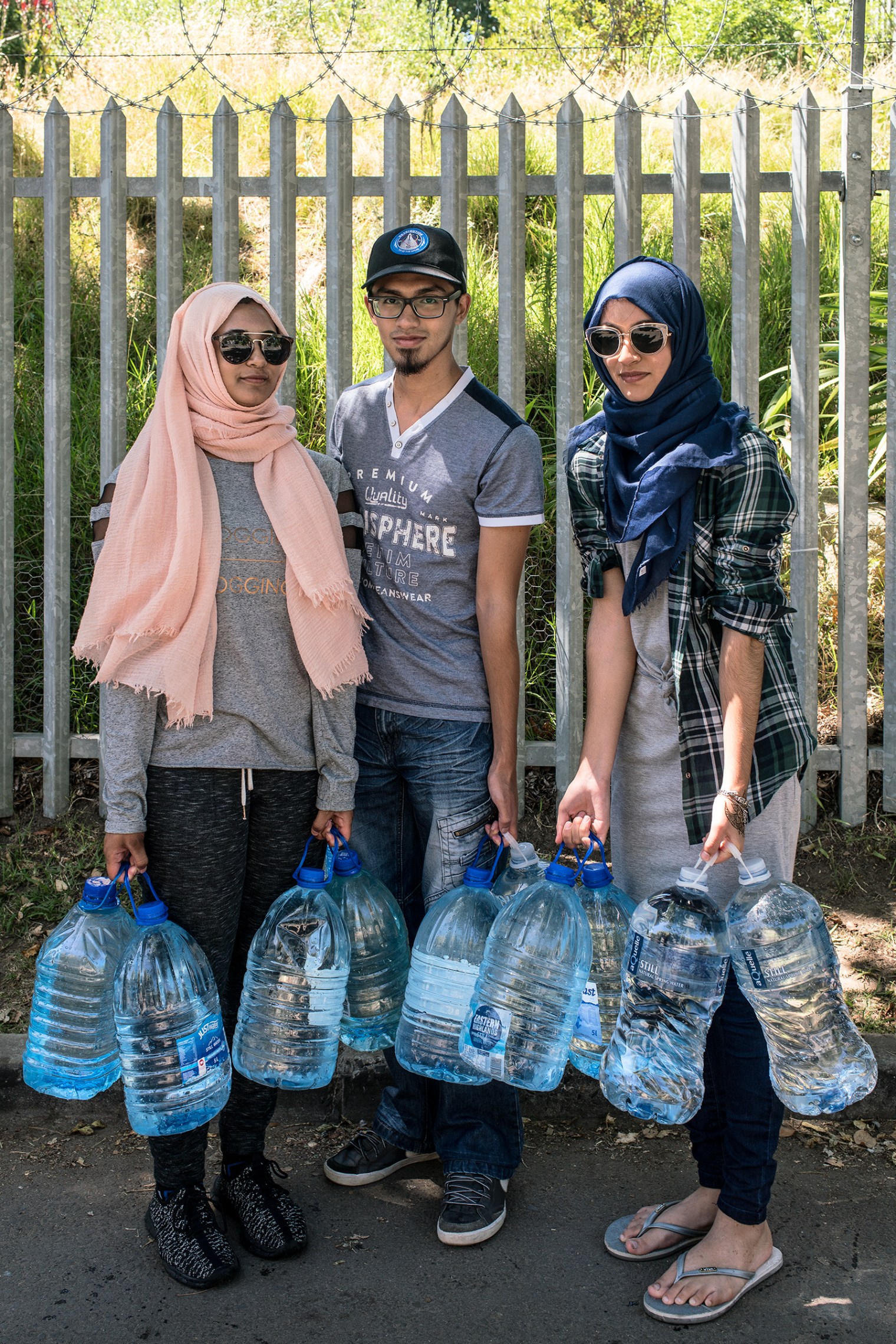 Obaidullah Cader, Muneerah Traut and Saajidah Cader collect water at the Newlands spring on Feb. 3. Mikhael Subotzky—Magnum Photos for TIME
Obaidullah Cader, Muneerah Traut and Saajidah Cader collect water at the Newlands spring on Feb. 3. Mikhael Subotzky—Magnum Photos for TIME
But the crisis didn’t start with one deluded mayor. It goes back decades. “City will run out of water ‘in 17 Years,'” declared a Cape Times headline as long ago as April 26, 1990. The story, quoting a Water Research Commission presentation in the country’s Parliament, went on to recommend a sewage-recycling plant to augment supplies from the city’s six rainfall-fed dams. Instead, Cape Town embarked on a laudable conservation effort, but it wasn’t enough.
Now the city is playing catch-up, installing expensive desalinization plants to purify seawater and scrambling to tap the underground aquifer. Only two of the seven water-augmentation projects are expected to be up and running by the time Day Zero kicks in. As with my back-ordered water tank, a little extra planning would have gone a long way toward staving off a crisis of unprecedented proportions.
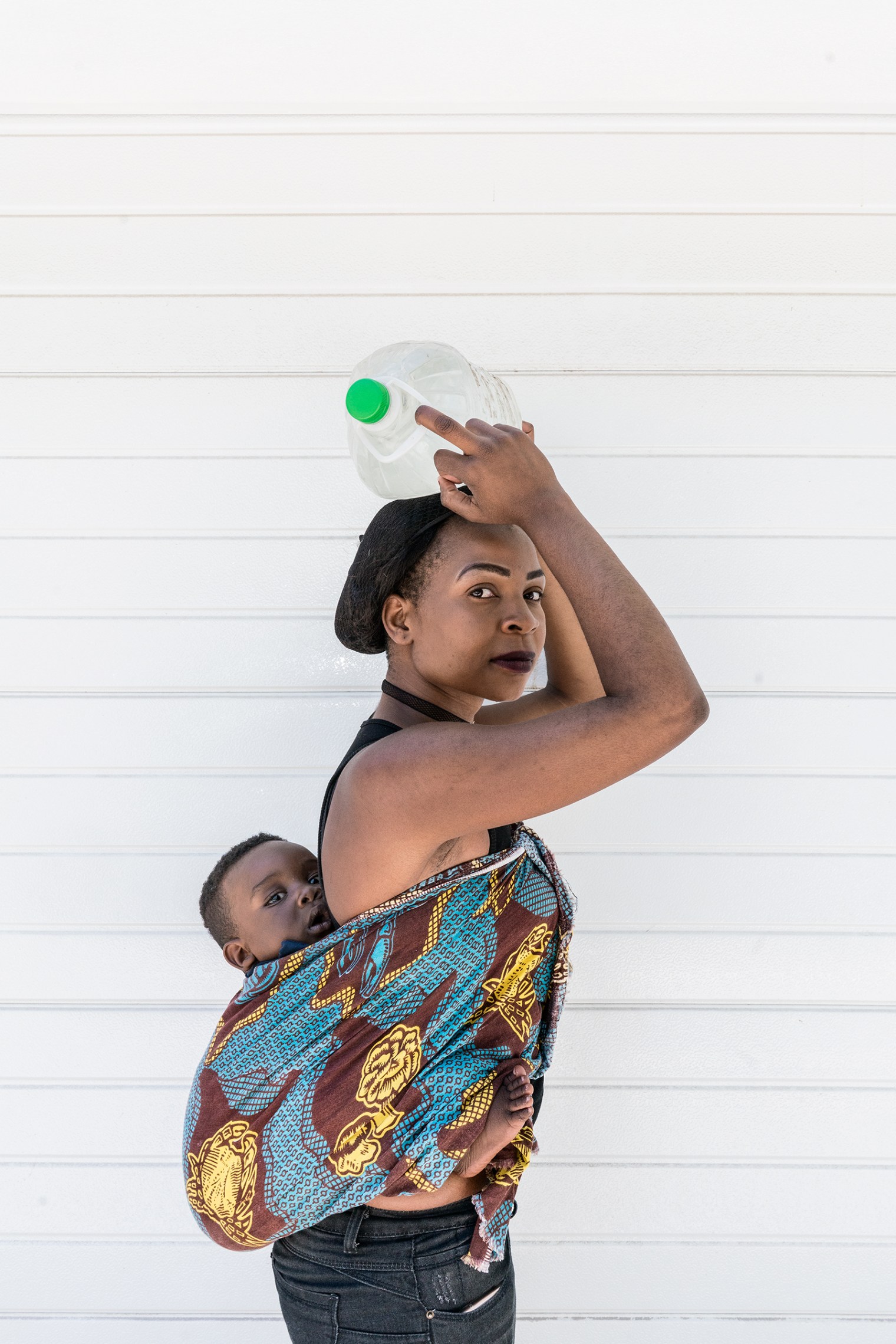 Mwai Halala, with her son, Jaden, holds water from Newlands on Feb. 3. Mikhael Subotzky—Magnum Photos for TIME
Mwai Halala, with her son, Jaden, holds water from Newlands on Feb. 3. Mikhael Subotzky—Magnum Photos for TIME
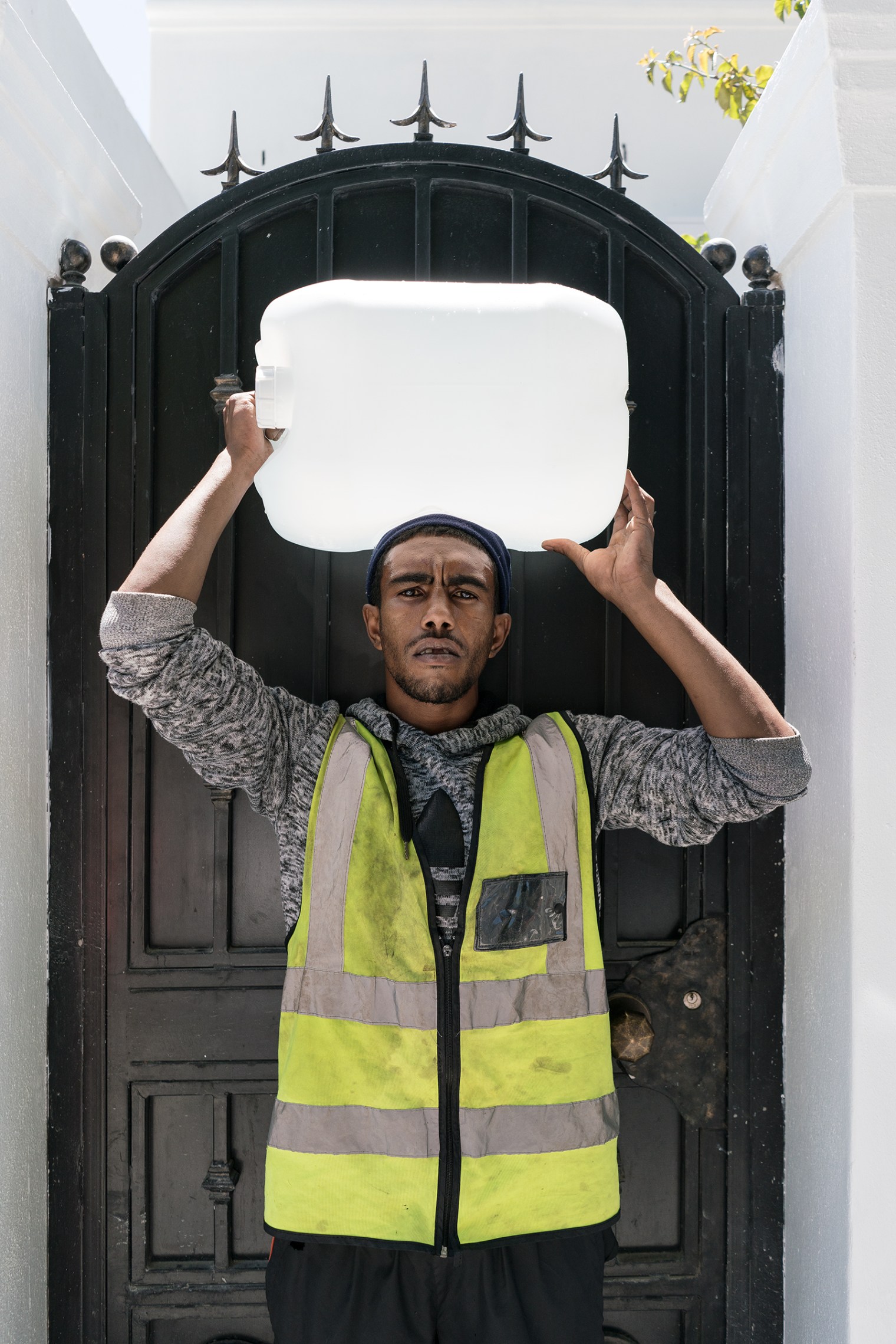 John Levi, a water porter at Newlands, on Feb. 3. Mikhael Subotzky—Magnum Photos for TIME
John Levi, a water porter at Newlands, on Feb. 3. Mikhael Subotzky—Magnum Photos for TIME
Cape Town may be the first major city to run out of water, but it won’t be the last. In Mexico City, residents are already experiencing cuts to their piped water supply, and officials in Melbourne (another city affected by drought) warn that the city is little more than a decade away from exhausting current water supplies. At one point, before a sustained deluge in 2015, the city of São Paulo was down to less than 20 days’ worth of water, according to the World Resources Institute, a Washington-based research organization that tracks the use of natural resources around the world. It reports that more than a billion people currently live in water-scarce regions and as many as 3.5 billion could experience water scarcity by 2025 if steps are not taken to conserve water now.
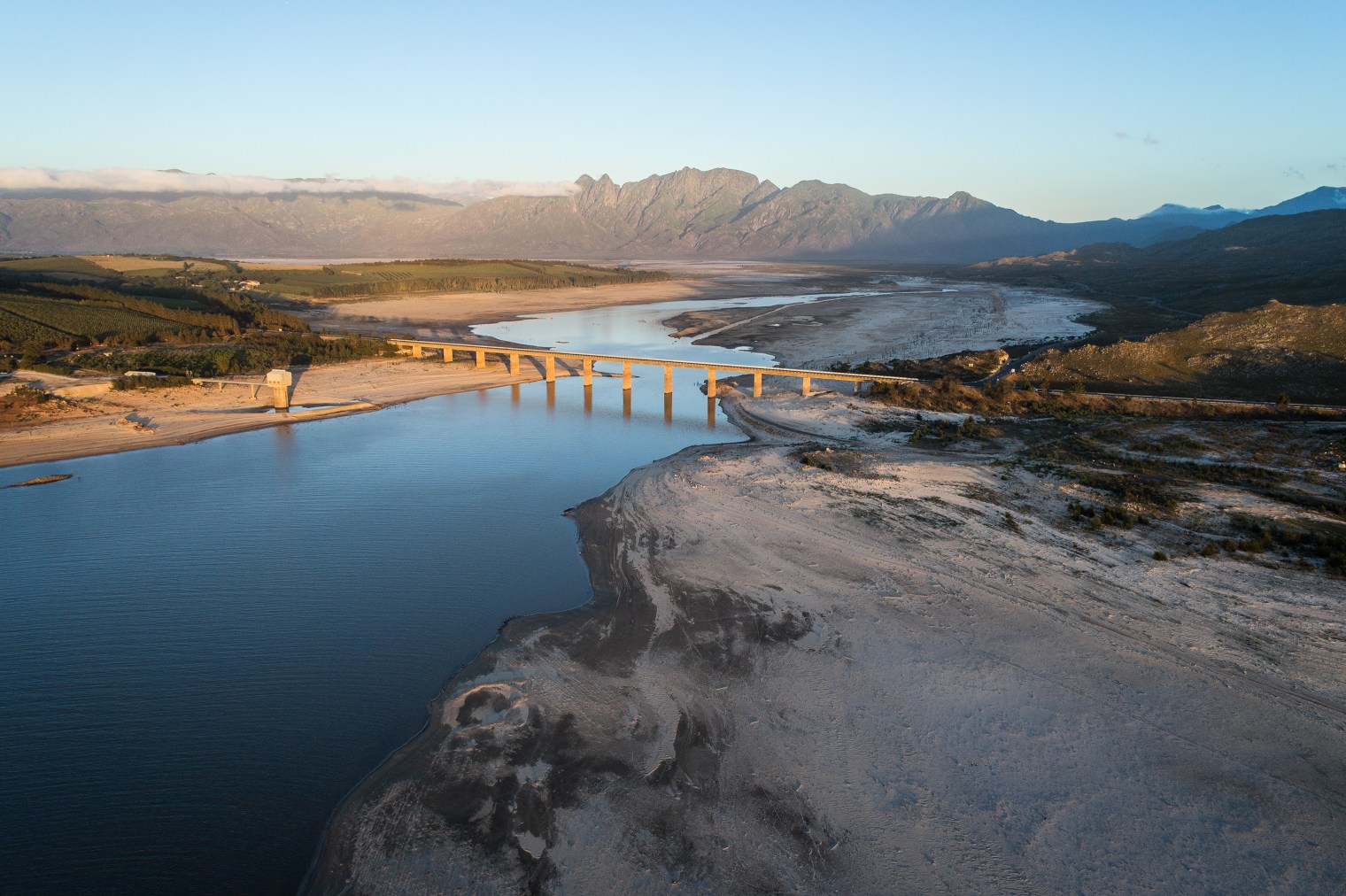 On Feb. 3, Theewaterskloof Dam was at 13% of capacity. Mikhael Subotzky and Johnny Miller for TIME
On Feb. 3, Theewaterskloof Dam was at 13% of capacity. Mikhael Subotzky and Johnny Miller for TIME
As the clock to Day Zero counts down, Capetonians are joining together to share water-saving tips online, and on air through call-in radio shows. Don’t boil food; bake it or cook it on the grill. Use paper plates, and wrap your serving platters in plastic wrap that you can peel off after each meal. Order pizza and eat straight from the box. Shower over a plastic tub and then use the water to wash clothes. Keep a bowl in every sink to collect water from washing hands. Use that and laundry water to flush toilets.
The tips, and the attention, have begun to work. On Jan. 30, Mmusi Maimane, head of the Democratic Alliance, a political party that has controlled Cape Town for a decade, announced that residents’ efforts were having an impact. But, he warned, unless consumption fell by at least 25%, Day Zero was still inevitable. The problem is, short of turning off neighborhood taps, there are few effective ways to cut off profligate users. Instead they are fined, in amounts that range from $41 to $248—which in some wealthy neighborhoods is hardly a deterrent.
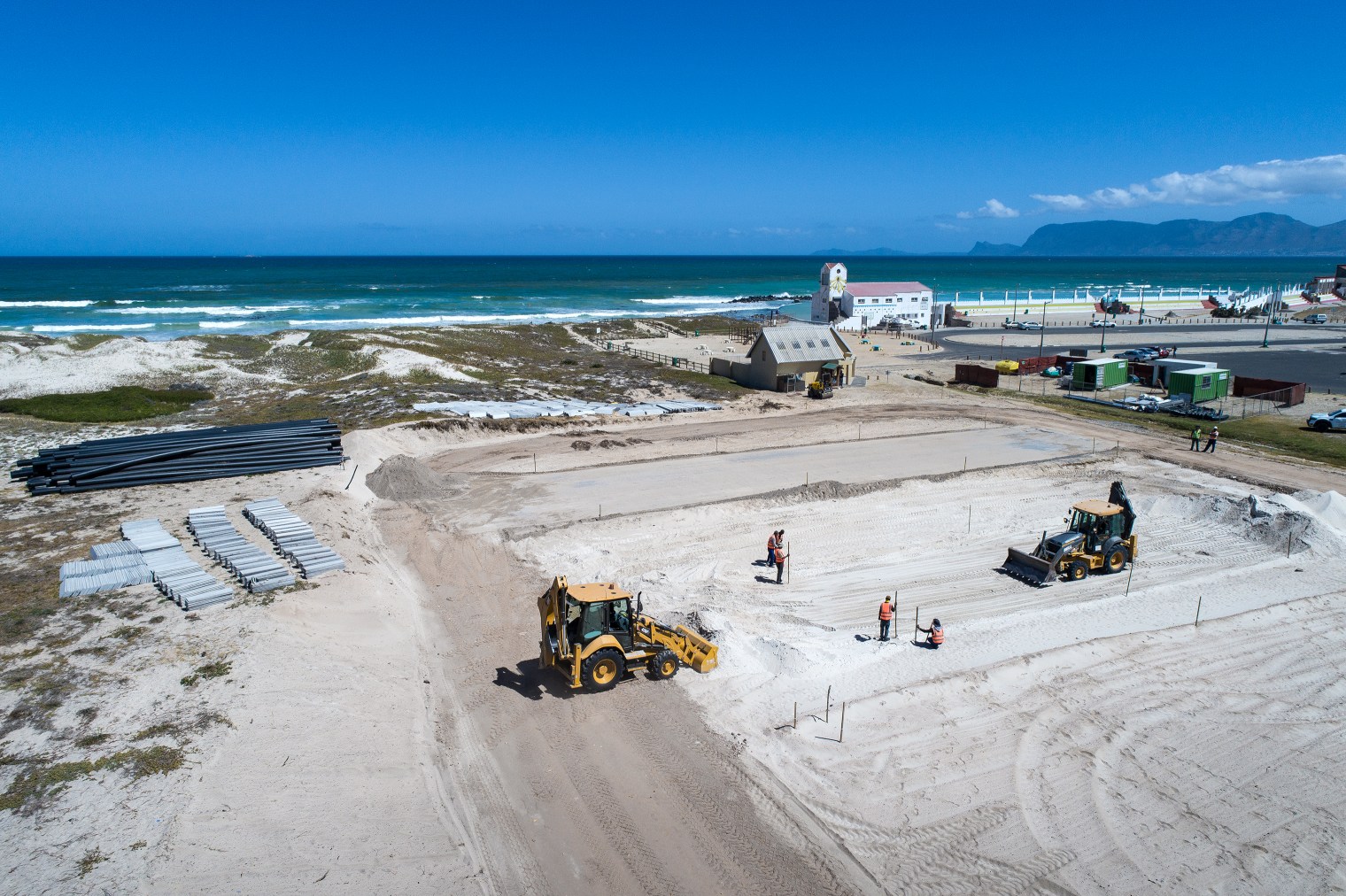 The future site of a desalination plant on Feb. 1. Mikhael Subotzky and Johnny Miller for TIME
The future site of a desalination plant on Feb. 1. Mikhael Subotzky and Johnny Miller for TIME
The urge to flee before the taps are switched off is strong. Some of our friends are planning to temporarily repatriate themselves to homes in the U.S. and Europe. Businesses are thinking of relocating to Johannesburg, a two-hour flight away, for the duration. I, for one, plan to stick it out. After all, for the large number of South Africans who don’t live in the mainly white and affluent suburbs that still define Cape Town 25 years after the end of apartheid, Day Zero is just another day in the life. Many township residents already line up at a central tap to get their daily water supply. In a nod to this reality—and out of fear of massive social unrest—city officials have said that townships and informal settlements will be exempted from Day Zero plans to shut off water mains.
I’m sure I can handle 6.6 gallons of water a day. I’m already down to two showers a week, and my daughter would go down to once a month if I let her. I’ve sacrificed a corner of my terrace to make way for my back-ordered water tanks. Once they arrive, I will start praying for rain and interspersing my bucket baths with baby-wipe top-ups. I’ll be cooking my meals on the grill and eating with my fingers. The toilets? Until now, I’ve been using my shower water to flush. But once the taps run dry, we won’t even have that. So I reopen my Internet browser and again type dry composting toilets. With any luck, they won’t have sold out.
Aryn Baker is TIME’s Africa Bureau Chief, based in Cape Town. Follow her on Twitter @arynebaker.
Mikhael Subotzky is a photographer represented by Magnum Photos. Follow him on Instagram @mikhael_subotzky.
Johnny Miller is a photographer and drone pilot based in Cape Town. He is the founder of AfricanDrone, a pan-African drone pilot community. Follow him on Instagram @millefotosa.